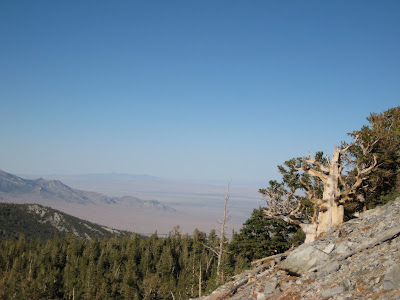On the alpine slopes of Wheeler Peak, on the eastern edge of Nevada, there stands a grove of bristlecone pine trees. Bristlecones are the oldest living organisms on the planet. They are twisted and grow slowly in the harshest of conditions. There are short growing seasons, harsh winds, and brutally cold temperatures. They grow slowly and have very hard wood. In fact, their wood is so hard it is resistant to disease and bugs. When such a tree eventually dies it continues standing for thousands of years. It does not decompose, it is so hard that it erodes. Slow growth and their unusual ability to adapt are the keys to their long lives. An interpretive sign read, "...[The tree's] ability to stand for centuries after death is directly related to the adversity of its life."
The sun was setting early behind Wheeler Peak as I stood in the grove of pines. I looked at the "grotesquely beautiful"tree in front of me. It was 3,200 years old. It's always a danger to anthropomorphize something, but I couldn't resist. What would such a tree say if it spoke? What is it afraid of and what does it hope for the future? What advice would it give me?
It awoke from dormancy as a seed at about 1190 BC. That was four years prior to the Trojan War. There are Seven Wonders of the Ancient World. This mighty pine is older than all but the Great Pyramid of Giza.
When the famous Hanging Gardens of Babylon were built, the pine had seen about 600 years pass by. It was already 900 years old when the Lighthouse of Alexandria, the tallest of man's creations for many centuries, guided sailors into the Egyptian harbor. It was alive and well when the great statue of the Greek god Helios which formed the Colossus of Rhodes was sculpted.


This tree had lived through the creation and the destruction of such mighty wonders as the Statue of Zeus at Olympia, the Mausoleum of Halicarnassus, and had lived through the earthquakes, fires, and mobs that destroyed them as human civilizations came and went. Indeed, this tree and the Great Pyramid of Giza are all that are left on that list. And there are bristlecones older than even the pyramids. These trees live far from human civilizations so they do not see the wonders man built or their passing away. But what would this venerable pine think about the swift passage of human history? What would it say about political parties that come and go, the wars won and lost, or all the changes that mark human life? I imagine that this tree was more like Treebeard, the ancient ent from Tolkien's Lord of the Rings. Treebeard was concerned about the health of his forest and the constant earthy elements of water, air, and sunlight. The bristlecones have seen centuries upon centuries and have survived against all of nature's challenges. The biggest threat that these trees face at this point is climate change. They already live in the harshest, coldest climates. As the planet warms, they (or their seeds) have no where to go to find a suitable habitat.
In the shadow of the mountain, under the branches of such trees, I was awed by the tenacity of the trees. The harsh conditions these trees grow in give them the strength to persist.
In the shadow of the mountain, under the branches of such trees, I was awed by the tenacity of the trees. The harsh conditions these trees grow in give them the strength to persist.
Sources: http://www.lhaasdav.com/timelines/timeline_30000_1000_bc.html, http://www.nps.gov/grba/planyourvisit/identifying-bristlecone-pines.htm



